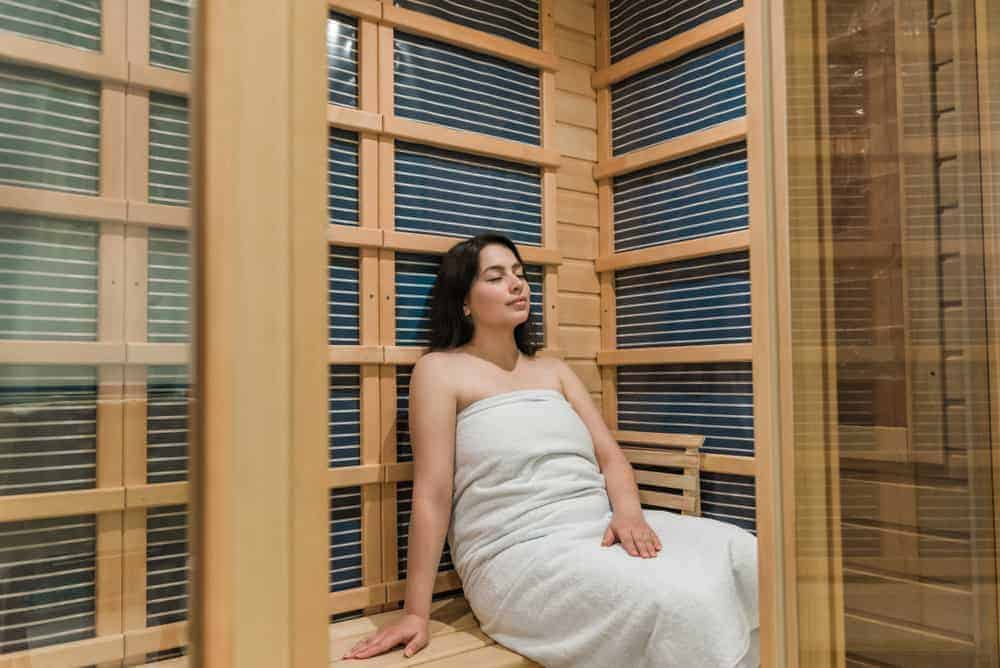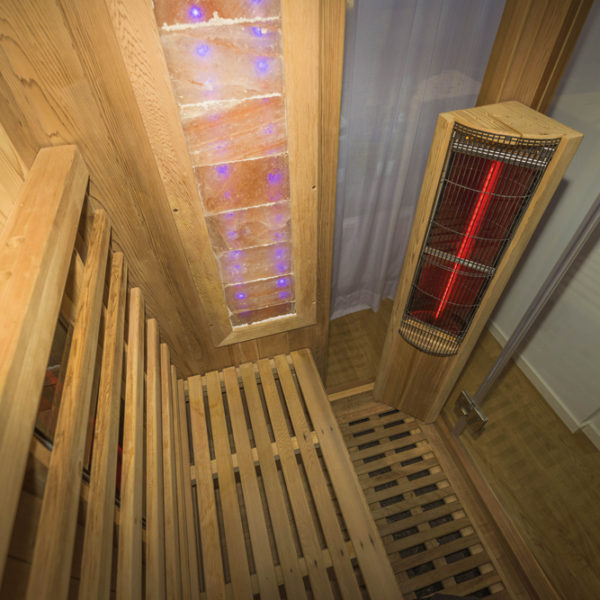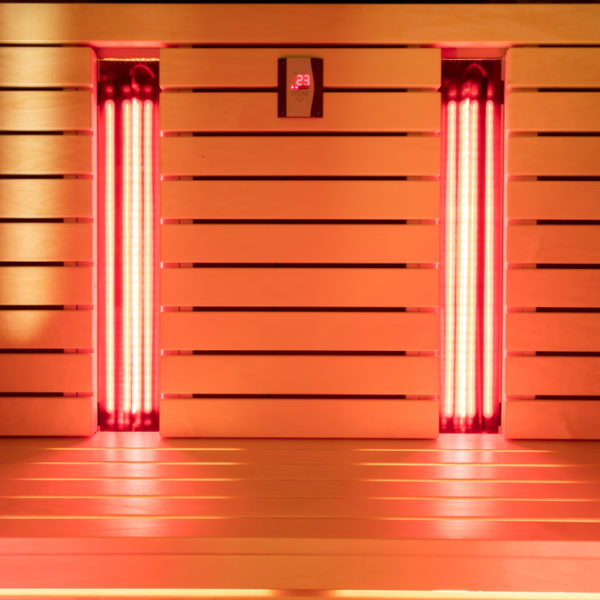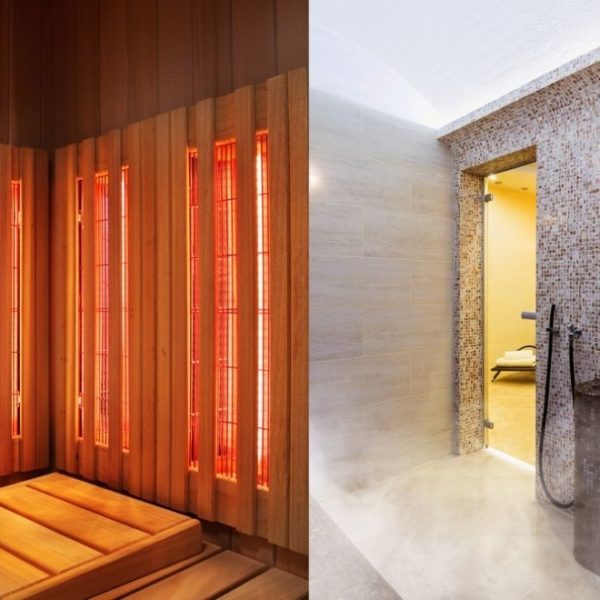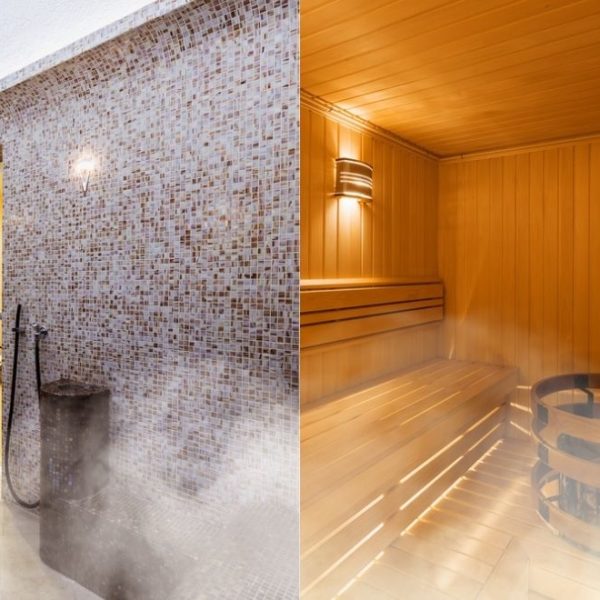Far-infrared saunas are suddenly all over the internet, and there are now countless YouTube videos and Instagram posts singing their praises. Even some celebrities are getting in on the act, which has helped turn infrared treatments into the latest healthcare craze.
But what do they do? What are the benefits? And are they backed up by science or just something made up by spa owners to sell more treatments? To answer these questions and more, here we list 15 far-infrared sauna benefits and discuss how much truth is behind them.
If you want to know a little bit more about the benefits of far-infrared rays, you can also check out this video before reading on.
Are Far Infrared Saunas Good for You?
What is an infrared sauna?
An infrared sauna differs from a regular sauna in several ways, but most of them are related to one simple fact – infrared saunas heat your body and induce sweating through infrared light rather than heated steam, unlike a traditional Finnish sauna.
The result of this is that infrared saunas run at lower temperatures than seasoned sauna-goers may be used to. The temperatures are usually in the 120-140°F range as opposed to the 200°F that some regular saunas can reach.
This means that an infrared sauna is less intense, and many people find them more comfortable. You can also say in for longer – and treatments last longer – which also makes the whole experience more relaxing.
However, the other part of using infrared instead of steam is that the infrared light can penetrate your body, and it is claimed this brings additional benefits that you won’t get simply by sweating in a regular sauna.
What is a far-infrared sauna?
Infrared is a type of electromagnetic radiation with a longer wavelength than light in the visual spectrum – which means we can’t see it with the naked eye.
However, infrared light is divided into near-infrared, medium-infrared and far-infrared rays. The longer the wavelength, the further the rays can penetrate your body, and with a wavelength of 5.6 to 1,000 micrometers, far-infrared is the best for sauna treatments.
This means that, although near- and medium-infrared saunas exist, if you want the best treatment with the most noticeable effects, you should choose a far-infrared treatment – and all the top installations offer this.
For the rest of this post, we will just use the term “infrared sauna” to refer to far-infrared saunas since those are the ones you should choose when possible.
What about infrared sauna blankets?
Infrared sauna blankets are a solution to the fact that not many places offer infrared sauna treatments – and those that do are not cheap.
Essentially, they are a kind of blanket – or perhaps more like a sleeping bag – that warms your body through infrared light.
It is generally thought they offer the same benefits as a full infrared sauna (although this hasn’t been proven), but you can use them in the comfort of your own home. They are a little expensive to buy initially, but if you use yours a lot, it will save you money in the long run.
Far-Infrared Sauna Benefits
So now let’s look at the supposed benefits of infrared saunas. Many of the benefits are shared with regular saunas – and in some cases, the shared benefits have been assumed rather than tested.
We will look at each of the benefits in turn, and we will also try to examine what evidence there is to see how far each claim is backed up by science.
Since infrared saunas are relatively new, in many cases, little research has been carried out.
This means that while there may be no current evidence to back up the claims, this doesn’t disprove them either, so many of the benefits that are not yet backed by science could still be proven true in the future.
1. Extend life
This one is perhaps the biggest claim of all – and also the hardest one to prove or disprove at present.
If all or some of the benefits below are proven to be true, then an extended life could logically be a benefit of using an infrared sauna. However, at this time, not enough work has been done on this question, so it’s impossible to say.
2. Raise heart rate and metabolism
When you step into an infrared sauna, the temperature increases your heart rate. This is part of your body’s natural cooling mechanism and isn’t disputed.
However, some people have suggested that since your heart rate increases when you exercise and exercise also increases your metabolic rate, it follows that increasing your heart rate in an infrared sauna must also increase your metabolic rate.
Unfortunately, this is false reasoning, so while there are benefits of increasing your heart rate, which we’ll come to next in #3, an infrared sauna doesn’t increase your metabolism.
3. Boost blood flow, improve circulation, reduce blood pressure
A commonly suggested advantage of saunas, including infrared saunas, is that they can help increase blood flow, improve circulation and help with cardiovascular function.
In one study – looking at regular saunas rather than infrared saunas – it was found that sauna use had the effect of reducing blood pressure in the participants.
Furthermore, another study demonstrated that far-infrared treatments allow your blood vessels to expand, making them better at adapting to changes in blood pressure – and since blood vessels that can’t do this are a sign of cardiovascular disease, this must be a good thing.
In sum, it seems that saunas in general – and far-infrared saunas in particular – have demonstrable advantages when it comes to your heart, blood and circulation.
In many cases, scientists haven’t yet been able to identify exactly what’s responsible for these benefits, but for most people, just knowing these clear benefits exist will be enough to convince them that infrared treatments are a worthwhile investment.
4. Boost immunity
The idea that saunas can help you “sweat out” a cold or clean out blocked sinuses has largely been debunked, but there is some evidence that regular sauna use can help prevent you from catching a cold in the first place.
This is based on one experiment that was conducted in Austria where one half of a group were told to use saunas regularly while the other half abstained.
The results showed that the group using saunas reported fewer colds than the non-sauna group, especially in the final three months of the study. However, the use or non-use of saunas was not found to affect the severity of a cold once it was contracted.
However, this study was small – and was not related specifically to infrared saunas – so while the results were encouraging, more research is required.
5. Reduce toxins
Unfortunately, the widely held belief that regular saunas and infrared saunas can help the body detoxify itself through sweating is unlikely to be true.
Sweating is the body’s reaction to overheating. When you get too hot, sweat glands in your skin produce sweat, which consists of 99% water. This water then evaporates, which helps to cool your skin.
Your body’s detoxification, on the other hand, is taken care of by the kidneys and the liver – so detox programs, including those based on “sweating it out”, simply aren’t grounded in science.
6. Reduce stress
Regular saunas are known to be good for reducing stress, and there’s no reason to think that infrared saunas don’t offer the same benefits.
In fact, since infrared versions are more comfortable and less intense, the effect could even be more pronounced – although no studies so far have demonstrated this.
7. Reduce inflammation, aches and pains
This is one of the areas where there is strong evidence to support this claim, especially in those with joint pain or rheumatoid arthritis.
Although the study that demonstrated this was small, and the reasons are not fully understood, it is thought that sitting in an infrared sauna can provide effective relief from these kinds of conditions.
8. Speed up recovery after exercise
The idea that infrared saunas can help with recovery after exercise has some scientific backing, although the studies were too small to be conclusive, and more work is required.
However, regular saunas are commonly used by athletes to help with recovery after sport, so it is reasonable to suppose that infrared saunas may also offer similar benefits.
9. Improve mood
A quick look through the many blog posts online extolling the virtues of infrared saunas would suggest that for one reason or another, whatever other benefits they may have, infrared saunas give users a mood lift, at least in the short term.
This could be due to the relaxation and stress relief they offer, or it could be just down to the placebo effect, but regardless of the reason, plenty of advocates of infrared saunas will tell you that sitting inside one for a treatment makes them feel happier.
10. Improve skin condition
This is a slightly controversial one since it’s one of the most commonly accepted benefits of infrared saunas – and yet, there are still those who deny its validity.
However, as with the improvement in mood, many people come out of their infrared sauna treatment feeling that their skin is glowing, so it’s likely there’s at least something to it.
11. Helps with weight loss
The idea that infrared saunas can help with weight loss comes mainly from the idea that increased heart rate equals increased metabolism.
However, as we have already seen, this isn’t the case, so sitting in an infrared sauna won’t help you lose weight – for this reason at least.
Another suggestion is that the infrared light also somehow burns fat, which is then sweated out through the skin. The idea is that infrared light penetrates the body and then somehow clears your system of both body fat and blood-floating fats.
Unfortunately, this is also unlikely to be true.
Some might counter this by pointing to research that seems to suggest otherwise – participants in this study showed an average of a 4% drop in body fat after four months of infrared sauna treatments.
However, the study didn’t take into account the diet and exercise habits of the participants, and since the group was so small, the results could be skewed by simple random chance.
That said, since infrared saunas can help reduce stress and improve recovery times after exercise, it is possible that they can still contribute to losing weight.
This is because stress increases your probability of eating unhealthy food or comfort-eating, while being able to return to the gym quicker may allow you to exercise more – both of which are factors that affect weight loss or gain.
12. Heal wounds
It has been claimed that far-infrared treatments can help soothe wounds or perhaps help them heal faster. Studies have shown this to be the case in rats, and it is suspected that the results could be reproduced in humans, but at the moment, no research has been completed.
13. Reduce side effects from diabetes
This benefit seems a little far-fetched and, since at present there is no real science to back it up, for the moment it can be discounted.
14. Reduce chronic fatigue syndrome
The causes of chronic fatigue syndrome are not well understood. There are also few treatments available for it, but experiments with infrared saunas have shown some promising results.
Although the study only comprised 15 participants, after four weeks of treatments, fatigue levels and pain were reported as being lower while mood ratings scored much higher.
Again, as with many studies involving infrared saunas, the study was too small to draw firm conclusions.
However, at least we can say the results were positive, and it is likely that the infrared treatments played a significant role in producing them.
15. Prevents cancer
No research suggests this is the case – and there is also no reason to believe it would be true.
Many benefits – some true, others more far-fetched
As you can see, there are lots of supposed benefits to far-infrared sauna treatments – so many, in fact, that you would be forgiven for thinking that infrared light was no less than a cure for everything!
However, while some of these claims are quite outlandish, others seem to be supported by the science. And even though some of the benefits have yet to be proven, this doesn’t mean they’re not real – so if you want to try, why not give it a go and decide for yourself?
